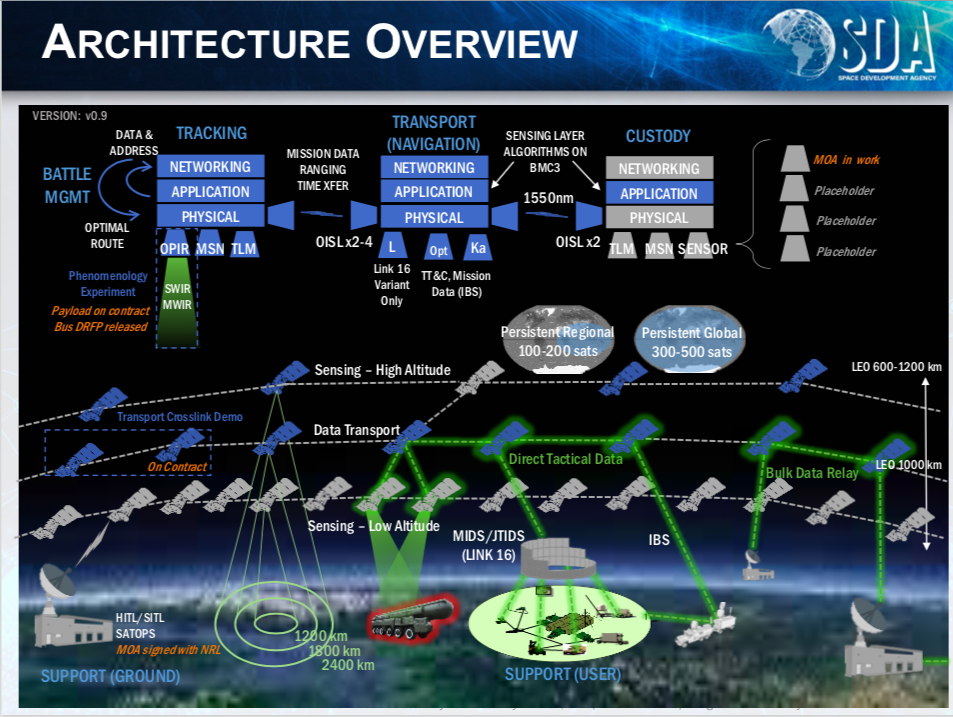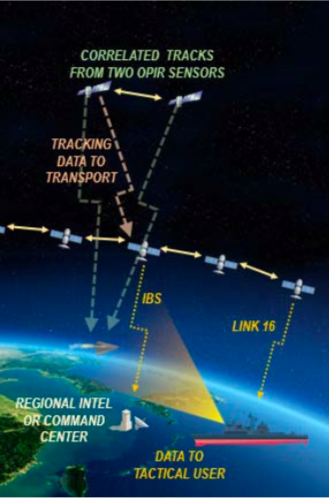
SDA’s latest “objective” space architecture
WASHINGTON: Instead of building ground stations around the world to link to the hundreds of satellites planned for its Low Earth Orbit (LEO) architecture, the Space Development Agency (SDA) plans to rent commercial capacity — a move that likely will both save money and speed operational capability.
The concept, SDA Director Derek Tournear told the Small Satellite Alliance yesterday, is that DoD will build a primary Missions Operation Center and Space Operations Center, but tap into commercial providers once the number of satellites on orbit begins to grow substantially. The primary Missions Operation Center, he said, is being developed with the Naval Research Laboratory (NRL) at its Blossom Point, Md., satellite tracking facility.
“As the proliferation grows [and] your constellations grow, you need to be able to reach out to ground entry points, all around the globe, so that you can have some kind of coverage,” he explained. “Our plan for that is to have a few sites … where we would would just rent time with what the commercial industry is building out there for these ground sites. And if we need to build a specific ground entry point for the laser comms or something like that, we can do that.”
One industry representative told Breaking D today that “there would be a lot of interest” in such a model from satellite operators. That includes established companies that already have built ground stations for their own satellites, as well as newcomers such as Amazon, with its Amazon Web Service Ground Station scheme.
One of the biggest challenges to mega-constellations in LEO has been the cost of building the ground stations required to uplink and downlink data. This is because satellites in LEO orbits (up to 2,000 kilometers above sea level) zip around at the speed of bullets, some 7.8 kilometers per second — meaning that any one satellite is over a station site on the ground only for a few minutes.
In other words, the laws of physics conspire to make communicating with LEO sats expensive and technically more challenging than with satellites in Geosynchronous Orbit, some 36,000 kilometers up. GEO satellites remain stable over one spot on the ground because their speeds match the speed of Earth’s rotation.

Tracking data is transferred to SDA’s data transport layer for dissemination to terrestrial receivers on the ground, in the air or at sea
The ground-station issue is also part of the reason why SDA is pursuing its so-called “data transport layer” designed as a “mesh network” that allow satellites to process data on board and shoot it back and forth to each other, via high speed optical links. It allows for a kind of ‘chain communication’ so that even if a remote sensing satellite that has just snapped a picture of a Chinese missile launcher isn’t over a ground facility, it can zap its information to another satellite that can transmit it back to Earth.
One of the persistent problems the Defense Department has is that it does not coordinate building of the ground segment with production of the space segment.
“That is always the part that people ignore when they’re talking about space infrastructure,” Tournear said. “People always forget about the ground aspects.”
Tournear said the first set of satellites launched by SDA — called Tranche Zero, comprising up to 20 data transport satellites — will do all of their data processing on the ground. However, the ultimate goal is to move processing on-board the satellites themselves, making them more autonomous. The plan is to do this over time via a spiral development process of constant iteration, that is at the heart of SDA’s mission and its overarching architecture for a set of various LEO-based capabilities that include the high-priority beyond-line-of-sight targeting, and tracking of fast-flying hypersonic missiles.
“The ultimate vision is that we perform all of this autonomy for our two main capabilities — beyond-line-of-sight targeting for time sensitive targets, and advanced missile detection tracking and targeting. We perform all of that in space on board with little to no interaction with the ground,” he explained.
“That’s the ultimate vision, but obviously that’s not going to happen for a while. So, for Tranche 0, all of that processing will be done on the ground,” he added. “And on Tranche 1, then that’s when we’ll have enough satellites up there that we can have essentially persistence over a region … and we’ll start to move more processing on board for autonomy. … With Tranche 2 global coverage, you’ll have a lot more autonomy onboard.”
Tournear was quick to stress that SDA also is developing plans so it can integrate with the satellite ground systems and receivers/radios already in use by the military services at the tactical edge. For example, SDA wants to ensure that “whatever we develop we want to make sure it accelerates” the Air Force’s Enterprise Ground System (EGS). Indeed, Tournear noted that one of the reasons for picking Blossom Point for the Missions Operation Center was that NRL is heavily involved in EGS development.
SDA also is working hard to ensure its architecture fits in with and supports various service plans for implementing DoD’s top-priority Joint All Domain Command and Control (JADC2) concept, he said. As Breaking D readers know, Defense Secretary Mark Esper in May ordered that all the services’ nascent command and control (C2) systems for enabling all-domain operations via JADC2 be able to link with SDA’s transport layer.

SDA Director Derek Tournear
“We’ve been working with very closely with primarily the Army to make sure that whatever they are fielding that is compatible with JADC2 is going to work to do command and control, as well as mission data dissemination, for our constellation,” he said.
SDA has an agreement with the Army to use their TITAN mobile ground system to also provide C2 for its satellites. “TITAN is seen as one of, in essence, our ground stations,” Tournear explained, “because that is going to be the quickest way for us to disseminate data to folks that can’t plug into the transport [layer.]
He hastened to add that the vision for the transport layer is that the satellites would use Link 16 to communicate directly with fielded weapon systems compatible with that NATO-standard data link. “But that’s not going to get you to the very edge, where you have a guy with a UHF transceiver. TITAN would be able to take it that far,” he said. “You go down to TITAN, and then TITAN can rebroadcast.”
He added that SDA is also working with Navy, although “they’re just a little quieter about some of the specifics about their technology,” and the Air Force (which he noted “has been the most vocal” about their JADC2 ambitions) on their Advanced Battle Management System (ABMS) family of systems. Specifically, that include apertureONE radio frequency antenna for receiving satellite signals, and radioONE, as well as the gatewayONE the service has already demonstrated in its firs ABMS On-Ramp exercise back in December, when it was used to link the incompatible F-22 and F-35 comms systems.

Advanced Battle Management System Overview
In his wide-ranging discussion, Tournear also noted the campaign spearheaded by his boss, DoD Research and Engineering czar Mike Griffin, to delay SDA’s integration with the Space Force. As Breaking D readers know, the issue of SDA’s place in the overall space acquisition chain has been controversial from day one — with a skeptical Congress in the 2020 National Defense Authorization Act (NDAA) mandating that it be folded into the Space Force by October 2022.
Griffin, his deputy Lisa Porter and Tournear co-authored an op-ed in Space News on Monday (we call dibs on the next one!) arguing that SDA needs more time as in independent body to establish its mission. “As a disruptor, SDA must be allowed to operate outside of legacy acquisition systems until it has had time to innovate, flourish and deliver,” they wrote.
“I would contend that we need enough runway to be able to demonstrate that military utility,” Tournear said, so that “at a certain point, it won’t be that we will be brought in begrudgingly. “We want to all have the same mission and go for it, but we have to be able to demonstrate that constructive disruption first.”
He said that SDA is going to launch Tranche 0 at the end of 2022 and demonstrate its capabilities on-orbit during 2023. Following that, it will be the “right time” to subsume SDA under Space Force.
“There will be enough critical mass at that point, and enough pull on the capabilities that it won’t be stopped. If you do it before that — anytime before we fly that Tranche and demonstrate the utility — I think it will be stopped.”
Norway’s top officer on his ‘biggest challenge,’ next frigate and new NATO neighbors
Gen. Eirik Kristoffersen, Norway’s Chief of Defense, talks to Breaking Defense about his plans for spending on new frigates and subs, the challenges of upgrading Norway’s “digital backbone” and refilling the military’s stocks.



























